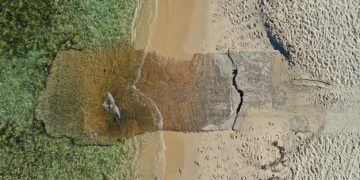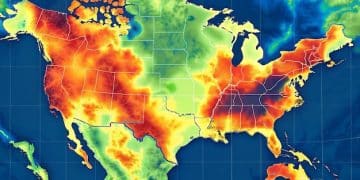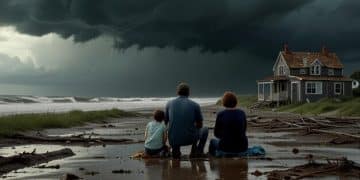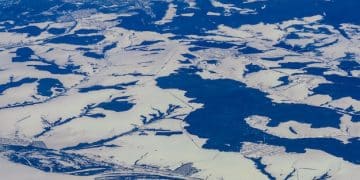US Coastline Sea Level Rise by 2050: Impacts on Ecosystems

By 2050, the US coastline is projected to experience a significant sea level rise, averaging 10-12 inches, with varied regional impacts profoundly affecting coastal ecosystems through increased inundation, habitat loss, and intensified storm surges.
Understanding the projected sea level rise for the US coastline by 2050 and the ensuing impacts on coastal ecosystems is more than an academic exercise; it is a critical endeavor shaping the future of our planet.
projected sea level rise for the US coastline by 2050: Understanding the Forecast
The anticipated rise in sea levels along the US coastline by 2050 is a subject of intense scientific scrutiny, driven by accelerating climate change. Current projections suggest a significant and unavoidable increase, impacting millions of Americans and vital natural habitats.
Drivers of Sea Level Rise
Several key factors contribute to the ongoing and projected sea level rise. These drivers are interconnected and amplify each other, leading to complex global and regional effects.
- Thermal Expansion: As ocean water warms from climate change, it expands, occupying more space. This phenomenon is a primary contributor to rising sea levels.
- Melting Glaciers and Ice Sheets: Large ice formations, particularly the Greenland and Antarctic ice sheets, are melting at unprecedented rates, adding vast quantities of water to the oceans.
- Land Subsidence: In many coastal regions, the land itself is sinking due to natural geological processes and human activities like groundwater withdrawal, effectively increasing relative sea level rise.
These drivers collectively determine the pace and extent of sea level rise. Their combined effects mean that even aggressive greenhouse gas reduction measures now will primarily influence outcomes beyond 2050, as much of the warming and ice melt is already “locked in.”
Detailed forecasts from agencies like the National Oceanic and Atmospheric Administration (NOAA) indicate that the contiguous US coastline is expected to see an average of 10-12 inches (25-30 cm) of sea level rise by 2050, relative to 2000 levels. Some regions, particularly the East Coast and Gulf Coast, are expected to experience even higher increases due to localized factors such as land subsidence and ocean currents.
The implications of these projections are far-reaching, setting the stage for transformative changes in coastal geomorphology, hydrology, and ecology. Understanding this baseline is crucial for effective adaptation planning and conservation efforts, offering a clearer picture of the challenges ahead for coastal communities and ecosystems along the US shoreline.
While the exact figures may vary slightly between models and assumptions, the consensus among climate scientists is clear: significant sea level rise by 2050 is a certainty, necessitating proactive measures rather than reactive responses.
Regional Variations: East Coast, Gulf Coast, and West Coast
Sea level rise will not be uniform across the United States. Regional geological features, ocean currents, and land subsidence rates contribute to significant variations, necessitating tailored approaches for each coastline.
Accelerated Rise on the East and Gulf Coasts
The US East Coast and Gulf Coast are particularly vulnerable to higher rates of sea level rise. Several factors exacerbate the issue in these regions.
- Ocean Currents: Changes in the Atlantic Meridional Overturning Circulation (AMOC) can influence sea levels along the East Coast, potentially leading to faster rise.
- Land Subsidence: Many areas along the Gulf Coast and parts of the Mid-Atlantic are experiencing significant land subsidence. This geological process, often exacerbated by groundwater extraction and natural compaction of sediments, means that the effective sea level rise, relative to the land, is higher than the global average.
- Topography: The relatively low-lying and flat topography of much of the East and Gulf Coasts makes them highly susceptible to inundation from even modest increases in sea level.
States like Florida, Louisiana, and parts of the Carolinas are already grappling with increased tidal flooding, illustrating the immediate consequences of these accelerated rates. Low-lying urban centers face perpetual challenges with infrastructure resilience and freshwater intrusion, transforming landscapes and daily life.

West Coast Dynamics
The West Coast, including California, Oregon, and Washington, faces a different set of challenges. While still vulnerable, the plate tectonics along this margin can sometimes lead to localized uplift, marginally offsetting the global sea level rise. However, this is not a universal protection.
Future projections for the West Coast indicate a rise, though perhaps slightly less pronounced than on the other coasts in some areas, yet still significant enough to cause substantial impacts. Coastal erosion, bluff instability, and saltwater intrusion into aquifers are primary concerns. The region’s diverse ecosystems, from rocky intertidal zones to estuaries, will respond uniquely to these changes. The episodic nature of storm surges, amplified by rising base sea levels, also poses a substantial threat to coastal communities and infrastructure on the West Coast.
Understanding these regional nuances is essential for developing effective adaptation strategies. A one-size-fits-all approach to sea level rise will be insufficient; instead, resilience planning must be tailored to the specific geological, oceanographic, and ecological characteristics of each coastal segment.
Impacts on Coastal Ecosystems: Salt Marshes and Mangroves
The projected sea level rise poses an existential threat to vital coastal ecosystems, particularly salt marshes and mangroves, which serve as natural buffers and critical habitats.
Threats to Salt Marshes
Salt marshes are highly productive ecosystems that provide numerous benefits, including storm surge protection, water filtration, and nursery grounds for fish and shellfish. However, their survival is intrinsically linked to their ability to migrate inland or accumulate sediment vertically at a rate equivalent to sea level rise. A rapid increase in sea level can overwhelm these processes.
- Inundation Stress: Increased flooding duration and depth can stress marsh plants, reducing their productivity and eventually leading to dieback.
- “Coastal Squeeze”: In many developed areas, natural marsh migration inland isBlocked by human infrastructure (e.g., roads, buildings). This phenomenon, known as “coastal squeeze,” prevents marshes from moving to higher ground as sea levels rise, effectively drowning them.
- Sediment Supply: Reduced sediment availability, often due to damming rivers or other human alterations to watersheds, further limits the ability of marshes to build vertically and keep pace with rising waters.
The loss of salt marshes signifies more than just ecological degradation; it means losing critical defenses against storms and valuable wildlife habitats. Their disappearance could lead to increased erosion, diminished water quality, and declines in commercially important fisheries.
Challenges for Mangrove Forests
Mangrove forests, particularly prevalent along the Gulf Coast and in Florida, are similarly vulnerable. These unique trees thrive in brackish water environments and provide unparalleled ecological services.
Like salt marshes, mangroves require stable hydrological conditions to survive and thrive. Rising sea levels can submerge their root systems for too long, depriving them of oxygen and leading to widespread mortality. While mangroves can also migrate inland, they face the same “coastal squeeze” challenges where human development prevents natural retreat.
The destruction of mangrove forests would result in several serious consequences:
- Increased coastal erosion due to the loss of their extensive root systems that stabilize shorelines.
- Loss of crucial nursery and foraging grounds for a vast array of marine species, including many fish, crustaceans, and birds.
- Reduced buffering capacity against hurricanes and tropical storms, leaving inland communities more exposed to storm surge and wind damage.
Protecting and restoring these ecosystems is paramount, not only for biodiversity but also for the long-term resilience of human coastal communities. Strategies often involve managed retreat, sediment enhancement, and land acquisition to facilitate natural migration where possible.
Freshwater Intrusion: A Silent Threat to Inland Ecosystems
Beyond the direct inundation of coastal areas, freshwater intrusion represents a critical, often unseen, impact of sea level rise. This phenomenon occurs when rising saltwater infiltrates freshwater aquifers and surface water bodies, fundamentally altering the hydrological balance of inland ecosystems.
Salinization of Aquifers
Many coastal communities and ecosystems rely on underground freshwater aquifers for drinking water and irrigation. As sea levels rise, the increased hydraulic pressure forces saltwater further inland and deeper into these aquifers. This process renders freshwater sources brackish or unusable, posing severe challenges for human populations and natural systems. The economic costs associated with finding alternative water sources or desalinating water can be enormous.
Impacts on Freshwater Wetlands and Forests
Freshwater wetlands, such as cypress swamps and freshwater marshes, are highly sensitive to changes in salinity. These ecosystems act as natural filters, control floods, and provide unique habitats. As saltwater encroaches, these freshwater-dependent plants and animals cannot adapt quickly enough, leading to widespread die-offs and ecological transformation. For instance, “ghost forests” are emerging in coastal areas as saltwater inundation kills freshwater trees, leaving behind skeletal remains.
The long-term effects of freshwater intrusion include:
- Loss of Biodiversity: Species adapted to freshwater conditions are displaced or perish, leading to a reduction in local biodiversity.
- Altered Nutrient Cycles: Changes in water chemistry affect microbial communities and nutrient availability, disrupting ecosystem functions.
- Reduced Agricultural Productivity: Farmlands become less productive as soil salinity increases, threatening livelihoods and food security in coastal agricultural regions.
Addressing freshwater intrusion requires comprehensive coastal management strategies that consider both surface and subsurface hydrology. This includes monitoring groundwater levels and salinity, implementing controlled drainage, and exploring opportunities for freshwater storage and recharge. The insidious nature of this threat means that its impacts may not be immediately apparent, but they are profound and long-lasting, reshuffling the very fabric of coastal ecosystems.
Threats to Coastal Wildlife and Biodiversity
The projected sea level rise presents profound and complex threats to coastal wildlife and biodiversity. Species that rely on specific coastal habitats for breeding, feeding, or migration face direct impacts from habitat loss and alteration.
Species Displacement and Habitat Loss
As coastlines recede and low-lying areas become permanently inundated, many species will lose their critical habitats. Shorebirds that nest on narrow beaches, marine turtles that lay eggs on sandy shores, and fish that rely on estuaries as nursery grounds are particularly vulnerable. The “coastal squeeze” effect, where development prevents natural habitat migration, intensifies this problem.
Examples of threatened species include:
- Seabirds: Many species, like piping plovers and least terns, nest directly on sandy beaches or in dune systems, which are highly susceptible to erosion and inundation.
- Marine Mammals: Some marine mammals, such as manatees, depend on specific estuarine vegetation that will be impacted by increased salinity.
- Coastal Amphibians and Reptiles: Species adapted to freshwater or brackish wetlands will suffer from saltwater intrusion, leading to population declines.
The fragmentation and loss of these habitats can lead to reduced population sizes, genetic isolation, and, in some cases, local extinctions. Species that are unable to migrate or adapt quickly enough will face significant challenges to their survival.
Food Web Disruptions and Disease
Changes in water temperature, salinity, and inundation patterns can disrupt delicate coastal food webs. For instance, the decline of salt marshes or mangrove forests will impact the abundance of the invertebrates and fish that feed on their organic matter, subsequently affecting larger predators.
Moreover, altered environmental conditions can influence disease prevalence. Warmer waters can promote the growth of pathogens, while stressed or displaced wildlife may become more susceptible to illness. For example, some oyster diseases thrive in altered salinity regimes, impacting shellfish populations and the ecosystems that rely on them.
The cumulative effect of habitat loss, species displacement, food web disruptions, and increased disease susceptibility paints a concerning picture for coastal biodiversity. Conservation efforts must integrate sea level rise projections into their planning, focusing on protecting key habitats, facilitating species migration corridors, and mitigating other stressors to enhance overall ecosystem resilience. Without targeted interventions, many iconic coastal species could face irreversible decline by 2050 and beyond.

Economic and Social Repercussions of Ecosystem Degradation
The degradation of coastal ecosystems due to sea level rise extends beyond ecological concerns, imposing significant economic and social costs on US coastal communities. These impacts ripple through various sectors, affecting livelihoods, infrastructure, and cultural heritage.
Fisheries and Aquaculture
Coastal ecosystems like salt marshes, mangroves, and estuaries serve as crucial nursery grounds for many commercially important fish, shrimp, and shellfish species. The disruption or loss of these habitats directly threatens the economic viability of commercial and recreational fisheries. Increased salinity due to saltwater intrusion also impacts aquaculture operations, particularly those raising freshwater or brackish-water species.
The decline in seafood stocks can lead to:
- Reduced income for fishing communities and related industries, such as processing plants and seafood markets.
- Higher prices for consumers due to decreased supply.
- Loss of traditional livelihoods and cultural practices associated with fishing.
The cascading effects can destabilize regional economies heavily reliant on coastal resources.
Tourism and Recreation
Healthy coastal ecosystems are paramount to the tourism and recreation industries. Beaches, scenic coastlines, and thriving aquatic environments attract millions of visitors annually, supporting countless jobs and businesses. Sea level rise exacerbates coastal erosion, degrades beaches, and damages natural attractions, directly impacting tourism revenues.
In addition, damage to infrastructure such as marinas, boardwalks, and coastal roads further hinders access and enjoyment, diminishing the appeal of coastal destinations. The economic toll on hotels, restaurants, and local shops can be substantial, leading to job losses and a decline in tax revenues for coastal municipalities.
Infrastructure and Property Value
Coastal ecosystems naturally protect human infrastructure from storm surges and erosion. Their degradation means these natural defenses are weakened, leaving buildings, roads, and utilities more vulnerable to damage from extreme weather events amplified by higher sea levels. This results in increased repair costs, insurance premiums, and the potential for widespread property devaluation in flood-prone areas.
Furthermore, the loss of natural open spaces and healthy ecosystems can diminish the quality of life for residents, impacting mental well-being and community cohesion. The intertwining of ecological health with economic and social stability underscores the urgency of addressing sea level rise and protecting coastal ecosystems.
Adaptation Strategies and Conservation Efforts
Addressing the impacts of sea level rise on coastal ecosystems requires a multi-faceted approach involving both proactive adaptation strategies and robust conservation efforts. These actions aim to enhance resilience, protect critical habitats, and mitigate future damage.
Coastal Protection and Restoration
Investing in natural and nature-based solutions is increasingly recognized as a cost-effective and ecologically beneficial approach to coastal protection. Unlike traditional “hard” infrastructure like seawalls, these solutions leverage natural processes and ecosystems.
- Salt Marsh and Mangrove Restoration: Projects focused on restoring and enhancing these ecosystems help to dissipate wave energy, trap sediment, and provide critical habitat. Techniques include planting vegetation, creating living shorelines from oyster reefs, and enhancing sediment supply.
- Dune Restoration: Rebuilding and fortifying sand dunes with vegetation helps to protect inland areas from storm surges and erosion, maintaining beach ecosystems.
- Oyster and Coral Reef Restoration: These underwater structures can reduce wave energy before it reaches the shore and provide vital marine habitats.
These natural defenses offer multiple benefits, including biodiversity enhancement, carbon sequestration, and improved water quality, beyond just coastal protection.
Managed Retreat and Land-Use Planning
In some highly vulnerable areas, “managed retreat” (or “relocation”) may be a necessary, albeit challenging, strategy. This involves the planned movement of infrastructure and communities away from advancing shorelines, allowing natural ecosystems to migrate inland. This approach helps prevent “coastal squeeze” and preserves ecosystem function.
Effective land-use planning is crucial:
- Zoning Regulations: Implementing codes that restrict development in vulnerable flood zones or discourage rebuilding in repeatedly flooded areas.
- Acquisition of Coastal Lands: Governments and conservation organizations purchasing land in low-lying areas to create natural buffers and allow for ecosystem migration.
- Strategic Relocation of Infrastructure: Moving critical public infrastructure like wastewater treatment plants and roads away from the coast.
While often controversial, these proactive measures can minimize long-term risks and societal costs compared to continuous, reactive interventions. They also facilitate the landscape-scale shifts needed for ecosystems to survive.
Policy and Funding Mechanisms
Strong policy frameworks and dedicated funding streams are essential for implementing adaptation and conservation efforts. This includes:
- Federal and State Funding: Allocating resources for coastal resilience projects, scientific research, and community-level planning.
- Incentives for Coastal Property Owners: Programs that encourage homeowners and businesses to elevate structures, relocate, or adopt sustainable land management practices.
- Cross-Jurisdictional Collaboration: Coordinating efforts among local, state, and federal agencies, as well as with tribal nations, to address sea level rise at appropriate scales.
Ultimately, a comprehensive and sustained commitment to these strategies, informed by the latest scientific projections, will be vital for protecting both human communities and the invaluable coastal ecosystems along the US shoreline well beyond 2050.
| Key Area | Brief Overview |
|---|---|
| 🌊 Projected Rise | US average 10-12 inches (25-30 cm) by 2050, relative to 2000. |
| 🌿 Ecosystem Impacts | Marsh/mangrove loss, habitat squeeze, freshwater intrusion, species displacement. |
| 💰 Socio-Economic | Threats to fisheries, tourism, property values, and infrastructure. |
| 🛡️ Adaptation Efforts | Nature-based solutions, managed retreat, policy, and funding are key strategies. |
Frequently Asked Questions
▼
The primary causes are thermal expansion of ocean water as it warms and the melting of glaciers and ice sheets. Global warming, driven by greenhouse gas emissions, is accelerating these processes, leading to the observed and projected increases in sea levels worldwide.
▼
The US East Coast and Gulf Coast are expected to experience higher rates of sea level rise compared to the West Coast. This is due to factors like land subsidence, ocean current dynamics, and the relatively low-lying topography of these regions, making them particularly vulnerable.
▼
Salt marshes face increased inundation stress and “coastal squeeze,” where human development prevents their natural inland migration. This can lead to widespread marsh dieback, loss of critical storm buffers, and destruction of vital habitats for numerous species.
▼
Freshwater intrusion is the process where rising saltwater infiltrates and contaminates freshwater aquifers and wetlands. It’s a major concern because it compromises drinking water supplies, destroys freshwater-dependent ecosystems like cypress swamps, and can impact agricultural productivity.
▼
Strategies include nature-based solutions like restoring salt marshes and dunes, managed retreat of infrastructure from vulnerable areas, and implementing new land-use planning regulations. These aim to enhance coastal resilience and protect both human communities and ecosystems.
Conclusion
The projected sea level rise for the US coastline by 2050 represents an undeniable challenge with profound implications for both human communities and natural ecosystems. The scientific consensus points to an average increase of 10-12 inches, but with significant regional variations amplifying impacts in vulnerable areas like the East and Gulf Coasts. The integrity of vital coastal ecosystems, from salt marshes and mangroves to freshwater wetlands, stands directly threatened by inundation, habitat loss, and saltwater intrusion. These ecological shifts will inevitably trigger substantial economic and social repercussions, affecting fisheries, tourism, and coastal infrastructure. While the scale of the challenge is immense, proactive adaptation strategies, including nature-based solutions, managed retreat, and robust policy frameworks, offer pathways to enhance resilience and mitigate the most severe outcomes. Addressing this complex issue demands sustained investment, collaborative governance, and an embrace of innovative solutions to safeguard America’s invaluable coastal heritage for generations to come. The time for thoughtful planning and decisive action is now.





